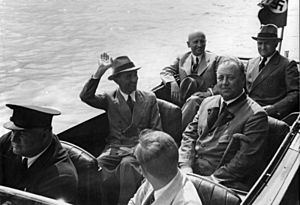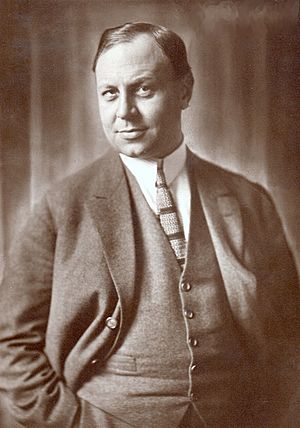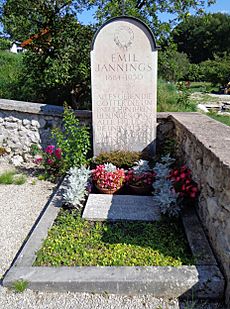Emil Jannings facts for kids
Emil Jannings (born Theodor Friedrich Emil Janenz, 23 July 1884 – 2 January 1950) was a famous actor from Germany. He was very popular in Hollywood during the 1920s.
Emil Jannings made history as the first person to win the Academy Award for Best Actor. He won it for his roles in two films: The Last Command and The Way of All Flesh. Even today, he is the only German actor to have won this award.
Jannings was well-known for working with directors F. W. Murnau and Josef von Sternberg. One of his most famous movies was The Blue Angel (Der blaue Engel) in 1930, where he starred with Marlene Dietrich. This film was supposed to help Jannings become a big star in the new "talkie" movies (films with sound). However, Marlene Dietrich became the breakout star instead. Later in his career, Jannings acted in films that supported the Nazi government. Because of this, he could not find work as an actor after World War II ended.
Contents
Early Life and Acting Start
Emil Jannings was born in Rorschach, Switzerland. His father, Emil Janenz, was an American businessman. His mother, Margarethe, was from Germany. Emil Jannings was a German citizen. When he was young, his family moved to Leipzig in Germany. After his father passed away early, they moved to Görlitz.
Jannings left school and even went to sea for a while. When he came back to Görlitz, his mother let him start training at the local theater. This is where his acting career began. From 1901, he worked with different theater groups in cities like Bremen and Nuremberg. Later, he joined the Deutsches Theater in Berlin, led by director Max Reinhardt.
By 1915, Jannings was a permanent actor there. He met other creative people like playwright Karl Vollmöller and actor Ernst Lubitsch. After World War I, these artists were important to the lively culture in Berlin during the 1920s. Jannings became very famous in 1918 for his role as Judge Adam in the play Broken Jug.
Film Career Highlights

Emil Jannings was a theater actor who started working in movies. At first, he felt that silent films didn't let him express himself enough. He signed a contract with the UFA film company. He starred in Die Augen der Mumie Ma (The Eyes of the Mummy, 1918) and Madame DuBarry (1919). Both films featured Pola Negri as the main female star.
He also appeared in the 1922 film version of Othello. In F. W. Murnau's 1924 film The Last Laugh (Der Letzte Mann), he played a proud hotel doorman who gets demoted to a restroom attendant. Jannings worked with Murnau on two more films: Tartuffe (Herr Tartüff, 1925) and Faust (1926), where he played Mephistopheles.
Hollywood Success
Because he was becoming so popular, Jannings was able to sign a deal with Paramount Pictures. He then moved to Hollywood, following his friends and fellow actors Lubitsch and Negri. His Hollywood career began in 1927 with The Way of All Flesh. This film is now lost. The next year, he starred in Josef von Sternberg's The Last Command.
In 1929, Jannings won the very first Oscar for his work in both of these films. He also worked with Sternberg on Street of Sin (1928). However, they sometimes disagreed about how Jannings should act in front of the camera.
His Hollywood career ended when "talkies" (movies with sound) became popular. His strong German accent was hard for American audiences to understand. In his film The Patriot (1928), another actor first dubbed his voice. But Jannings insisted, and his own voice was put back in. He then returned to Europe.
In 1930, he starred with Marlene Dietrich in The Blue Angel. This movie was filmed in both English and German at the same time.
Oscar Controversy
There's an interesting story about Jannings' Oscar win. According to author Susan Orlean, who wrote a book about the famous dog Rin Tin Tin, Jannings might not have been the first choice for the award. Orlean believes that Rin Tin Tin, a very popular German Shepherd dog movie star, actually won the most votes. However, the Academy was worried that people wouldn't take the awards seriously if a dog won the first Oscar. So, they decided to give the award to Emil Jannings, who was the human runner-up.
In 1960, after his death, Emil Jannings received a star on the Hollywood Walk of Fame. It is located at 1630 Vine Street, honoring his contributions to movies.
Films During Nazi Germany

After the Nazi party came to power in Germany in 1933, Jannings continued his acting career. He starred in several films that were made to support the Nazi government. These films often showed strong historical figures, promoting the idea of a powerful leader. Some of these movies include Der alte und der junge König (The Old and the Young King, 1934), Der Herrscher (The Ruler, 1937), Robert Koch (1939), Ohm Krüger (Uncle Kruger, 1941), and Die Entlassung (Bismarck's Dismissal, 1942). He also played his famous role in The Broken Jug again. The Minister of Propaganda, Joseph Goebbels, even called Jannings an "Artist of the State."
Filming for his last movie, Wo ist Herr Belling?, stopped when the Allied Powers entered Germany in 1945. Jannings reportedly carried his Oscar with him to show that he had worked in Hollywood. However, because he had acted in films that supported the Nazi government, he had to go through a process called denazification. This effectively ended his acting career.
During this same time, Marlene Dietrich, his co-star from The Blue Angel, became a U.S. citizen. She was an important activist against the Nazis. She spent much of the war entertaining soldiers and broadcasting messages for the OSS. Dietrich strongly disliked Jannings for his connections to the Nazis. She later called him a "ham," meaning an actor who overacts.
Later Years and Death
Emil Jannings moved to Strobl near Salzburg, Austria. He became an Austrian citizen in 1947. He passed away in 1950 at the age of 65 from liver cancer. He is buried in the St. Wolfgang cemetery. His Best Actor Oscar is now on display at the Berlin Filmmuseum.
Family Life
Emil Jannings was married four times. His first three marriages ended in divorce. His last marriage lasted until his death. His last three wives were German stage and film actresses: Hanna Ralph, Lucie Höflich, and Gussy Holl. He had one daughter, Ruth-Maria, who was born in 1920 from his first marriage to Lucy Höfling.
In Popular Culture
- In the 2009 movie Inglourious Basterds, directed by Quentin Tarantino, a made-up version of Jannings is shown. This fictional character dies at the end of the film.
- In the 1972 film Cabaret, the singer Sally Bowles (Liza Minnelli) is at a fancy dinner party. She tries to impress someone by saying she is a friend of Emil Jannings.
Filmography
| Year | Title | Role | Notes |
|---|---|---|---|
| 1914 | Arme Eva | ||
| Im Schützengraben | |||
| Passionels Tagebuch | |||
| 1916 | Aus Mangel an Beweisen | Dr. Langer | |
| Die Bettlerin von St. Marien | Baron Gelsburg | ||
| Frau Eva | |||
| Im Angesicht des Toten | Paul Werner | ||
| Life Is a Dream | |||
| A Night of Horror | Banker | ||
| Stein unter Steinen | |||
| 1917 | Das fidele Gefängnis | Quabbe, the jailer | The Merry Jail (Europe: English title) |
| When Four Do the Same | Segetoff | ||
| Hoheit Radieschen | |||
| The Marriage of Luise Rohrbach | Wilhelm Rohrbach | ||
| Der Zehnte Pavillon der Zitadelle | |||
| Das Geschäft | S. H. Haßler | ||
| Lulu | |||
| The Ring of Giuditta Foscari | |||
| The Sea Battle | |||
| Unheilbar | |||
| 1918 | The Seeds of Life | James Fraenkel, Börsenmarktler John Smith, amerikanischer Ingenieur |
|
| The Eyes of the Mummy | Radu, an Arab | ||
| Fuhrmann Henschel | |||
| Nach zwanzig Jahren | Horst Lundin 'Korn' | ||
| 1919 | Rose Bernd | Arthur Streckmann | |
| Madame DuBarry | Louis XV | a.k.a. Passion | |
| Vendetta | Tomasso | ||
| The Daughter of Mehemed | Vaco Juan Riberda, Fabrikbesitzer | ||
| The Man of Action | Jan Miller | ||
| 1920 | Colombine | Carlo | |
| Anna Boleyn | Henry VIII | a.k.a. Deception | |
| The Skull of Pharaoh's Daughter | Osorcon, Pharao of Egypt | ||
| Algol | Robert Herne | ||
| The Big Light | Lorenz Ferleitner | ||
| Kohlhiesel's Daughters | Peter Xaver | ||
| 1921 | The Rats | Bruno | |
| The Oath of Peter Hergatz | |||
| Danton | Georges Danton | a.k.a. All for a Woman | |
| The Bull of Olivera | General François Guillaume | ||
| The Brothers Karamazov | Dimitri Karamasoff | a.k.a. Die Brüder Karamasoff | |
| 1922 | Peter the Great | Peter the Great | a.k.a. Peter der Große |
| Othello | Othello | ||
| The Loves of Pharaoh | Pharao Amenes | a.k.a. Das Weib des Pharao | |
| The Countess of Paris | Ombrade | ||
| 1923 | All for Money | S. I. Rupp | |
| Tragedy of Love | Ombrade | ||
| 1924 | The Last Laugh | Hotel Porter | The Last Laugh (USA) |
| Husbands or Lovers | Husband | ||
| Waxworks | Harun al-Rashid | ||
| Quo Vadis | Nero | Extant | |
| 1925 | Variety | Boss Huller | a.k.a. Jealousy (USA) |
| Love is Blind | Emil Jannings | ||
| 1926 | Tartuffe | Tartuffe | |
| Faust – A German Folktale | Mephisto | Extant | |
| 1927 | The Way of All Flesh | August Schilling | Academy Award for Best Actor; Lost film |
| 1928 | Sins of the Fathers | Wilhelm Spengler | excerpts and clips are preserved of this film. Unconfirmed about the total film |
| The Patriot | Czar Paul I | Lost film | |
| Street of Sin | Basher Bill | Lost film | |
| The Last Command | Gen. Dolgorucki / Grand Duke Sergius Alexander | Academy Award for Best Actor; Extant | |
| 1929 | Betrayal | Poldi Moser | |
| 1930 | Darling of the Gods | Albert Winkelmann | a.k.a. Darling of the Gods |
| The Blue Angel | Prof. Immanuel Rath | a.k.a. The Blue Angel (USA) | |
| 1932 | Storms of Passion | Gustav Bumke | a.k.a. Stürme der Leidenschaft a.k.a. Tempest |
| 1933 | Die Abenteuer des Königs Pausole | King Pausole | a.k.a. The Adventures of King Pausole |
| The Merry Monarch | |||
| 1934 | The Black Whale | Peter Petersen | a.k.a. The Black Whale (International: English title) |
| 1935 | The Old and the Young King | Frederick William I of Prussia | a.k.a. The Making of a King (USA) |
| 1936 | The Dreamer | Direktor Prof. Niemeyer | |
| 1937 | The Broken Jug | Adam, Dorfrichter | a.k.a. The Broken Jug |
| The Ruler | Matthias Clausen | ' | |
| 1939 | Robert Koch | Robert Koch | |
| Der Trichter. (Nr. III) | scenes deleted | ||
| 1941 | Ohm Krüger | Paul Kruger | a.k.a. Uncle Kruger (International: English title) |
| 1942 | Die Entlassung | Otto von Bismarck | a.k.a. Bismarck's Dismissal (UK) |
| 1943 | Altes Herz wird wieder jung | Fabrikdirektor Hoffmann | |
| 1945 | Wo ist Herr Belling? | Firmenchef Eberhard Belling | a.k.a. Where Is Mr. Belling? |
See also
 In Spanish: Emil Jannings para niños
In Spanish: Emil Jannings para niños



